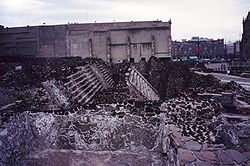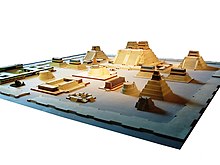| Revision as of 14:27, 31 October 2008 editSimon Burchell (talk | contribs)Autopatrolled, Extended confirmed users, Pending changes reviewers, Rollbackers57,611 editsm add notes section← Previous edit | Revision as of 14:28, 31 October 2008 edit undoSimon Burchell (talk | contribs)Autopatrolled, Extended confirmed users, Pending changes reviewers, Rollbackers57,611 edits add section breakNext edit → | ||
| Line 6: | Line 6: | ||
| The teocalli was mostly destroyed in ] after the conquest of the Aztec empire by the ] ]es under the leadership of ]. However, remains of the lower portions of the temple complex have been discovered by modern ]s buried under a portion of modern Mexico City. | The teocalli was mostly destroyed in ] after the conquest of the Aztec empire by the ] ]es under the leadership of ]. However, remains of the lower portions of the temple complex have been discovered by modern ]s buried under a portion of modern Mexico City. | ||
| ==The temple== | |||
| Numerous smaller buildings and platforms associated with the temple formed a closely-situated complex around its base. A ] relief depicting a '']'', or "skull rack", decorated one platform leading to the temple. | Numerous smaller buildings and platforms associated with the temple formed a closely-situated complex around its base. A ] relief depicting a '']'', or "skull rack", decorated one platform leading to the temple. | ||
Revision as of 14:28, 31 October 2008



The Templo Mayor (commonly known by this Spanish name, meaning "Great Temple") was the main temple of the Aztec capital of Tenochtitlan, now (modern Mexico City). The temple rose 60 m (197 ft) above the city's ritual precinct (teocalli), surmounted by dual shrines to the deities Huitzilopochtli (god of war and sun) and Tlaloc (god of rain and fertility).
The teocalli was mostly destroyed in 1521 after the conquest of the Aztec empire by the Spanish conquistadores under the leadership of Hernán Cortés. However, remains of the lower portions of the temple complex have been discovered by modern archaeologists buried under a portion of modern Mexico City.
The temple
Numerous smaller buildings and platforms associated with the temple formed a closely-situated complex around its base. A stucco relief depicting a tzompantli, or "skull rack", decorated one platform leading to the temple.
The temple was enlarged at least seven times, and for the last time in 1487.
The temple symbolizes both the Aztec world and the battle between Huitzilopochtli, the god of war and his sister Coyolxauhqui, goddess of the moon. According to the Aztec world vision, the universe was divided into three levels, 1) the thirteen skies above the Earth 2) the Earth, particularly the four cardinal directions and 3) the realm of the dead, called Mictlan. The platform of the temple represented the Earth, the skies were represented by the buildings built on the platform and Mictlan was represented by stairs leading down between the dual temples toward a tzompantli altar, decorated with 240 stucco-covered stone skulls.
The south side of the temple is dedicated to the story between the god of war and his sister. According to legend, their mother, Coatlicue became pregnant with Huitzilopochtli when she came upon a little ball of feathers which she put against her breast. When her children, the Centzonhitznahua people and the goddess Coyolxauhqui found out about the pregnancy, they were angered by the indignity such a pregnancy brought about. They plotted to kill Coatlicue for this. However, the unborn Huitzilopochtli told his mother that he would protect her. When Coyolxauhqui came to kill Coatlicue, Huitzilopochtli was suddenly born, armed with a fiery serpernt, which he used to kill his sister and throw her body from a hill to be smashed on the rocks below. After this, he then killed or expelled the Centzonhitznahua people.
The Templo Mayor was excavated between 1978 and 1987 in a major project directed by Eduardo Matos Moctezuma.
Notes
- Matos Moctezuma 1988, 1994, p.9.
- ^ Galindo, Carmen (2002). Mexico City Historic Center. Mexico City: Ediciones Nueva Guia. pp. 32–39. ISBN 968 5437 29 7.
{{cite book}}: Unknown parameter|coauthors=ignored (|author=suggested) (help)
References
- Díaz del Castillo, Bernal (1963) . The Conquest of New Spain. Penguin Classics. J.M. Cohen (trans.) (6th printing (1973) ed.). Harmondsworth, England: Penguin Books. ISBN 0-14-044123-9. OCLC 162351797.
{{cite book}}: templatestyles stripmarker in|author=at position 1 (help)CS1 maint: numeric names: authors list (link) - Matos Moctezuma, Eduardo (1988). The Great Temple of the Aztecs: Treasures of Tenochtitlan. New Aspects of Antiquity series. Doris Heyden (trans.). New York: Thames & Hudson. ISBN 0-500-39024-X. OCLC 17968786.
{{cite book}}: templatestyles stripmarker in|author=at position 1 (help)CS1 maint: numeric names: authors list (link) - Matos Moctezuma, Eduardo (1998). Vida y muerte en el Templo Mayor (3rd edition ed.). México D.F.: Fondo de Cultura Económica. ISBN 968-16-5712-8. OCLC 40997904.
{{cite book}}:|edition=has extra text (help); templatestyles stripmarker in|author=at position 1 (help)CS1 maint: numeric names: authors list (link) Template:Es icon - "Most Important Offering in Past 30 Years Discovered in Great Temple" (Press release). Oficina de la Presidencia de la República, México. 2008-06-08. Retrieved 2008-06-10.
{{cite press release}}: Check date values in:|date=(help); templatestyles stripmarker in|publisher=at position 1 (help)
Gallery
-
Carving of Mayahuel at the Templo Mayor site's museum
-
Disk depicting a dismembered Coyolxauhqui which was found during construction in 1978 in Mexico City. Its discovery led to the excavation of the Templo Mayor.
-
Scale models of chinampas used by the Aztecs in the lakes surrounding Tenochititlan on display at the museum of the Templo Mayor.
-
Model of the Aztec island city of Tenochtitlan outside of the Templo Mayor in Mexico City
-
View of Templo Mayor ruins in Mexico City
-
View of ruins of the "Eagle" building of the Templo Mayor complex. The roof is there to protect the remains of paintings that are inside.
-
View of Eagle building and building A in the Templo Mayor complex. The ruins of the main temple are in the background.
-
Inside the protected area of the Eagle Building of the Templo Mayor complex in Mexico City. Remants of the original paint can still be seen.
-
Close up of bas reliefs of eagle warriors in the Eagle building of the Templo Mayor complex. Some of the original paint can still be seen.
-
View of the ruins of the main temple of the Templo Mayor complex. The main city cathedral is visible just behind the ruins and the top of the Torre Latino is visible in the background.
-
Scale model of downtown modern Mexico City. In the center back is the Cathedral. The Zocalo (main plaza) is immediately to the left of the cathedral. The Templo Mayor site is at the 4 o'clock position from the cathedral.
-
Wall display of stone masks found at the Templo Mayor site on display at the Templo Mayor museum in Mexico City.
-
Stone blades called "pederales" on display at the museum of the Templo Mayor in Mexico City. These blades were created for ritual uses, including human sacrifice and often decorated with faces.
-
Stone box and contents found at the Templo Mayor in Mexico City. This was only one of the many offerings found here.
External links
19°26′06″N 99°07′53″W / 19.43500°N 99.13139°W / 19.43500; -99.13139
Categories: